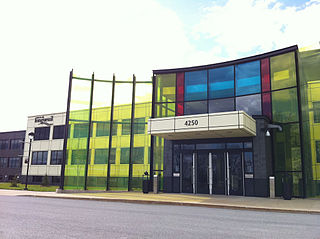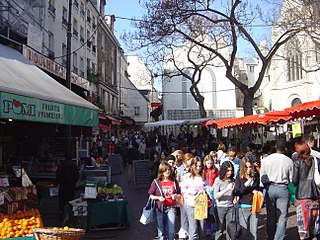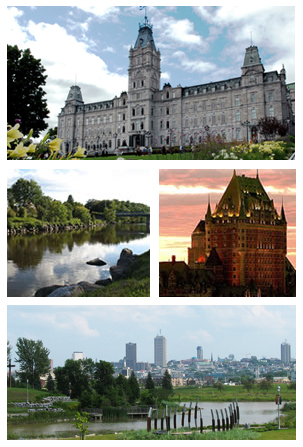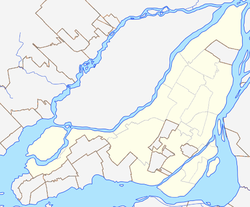
The Place de la Concorde is one of the major public squares in Paris, France. Measuring 7.6 ha in area, it is the largest square in the French capital. It is located in the city's eighth arrondissement, at the eastern end of the Champs-Élysées.

Longueuil is a city in the province of Quebec, Canada. It is the seat of the Montérégie administrative region and the central city of the urban agglomeration of Longueuil. It sits on the south shore of the Saint Lawrence River directly across from Montreal. The population as of the Canada 2016 Census totalled 239,700, making it Montreal's second largest suburb, the fifth most populous city in Quebec and twentieth largest in Canada.

Rue Mouffetard is a street in the 5th arrondissement of Paris, France.

Old Montreal is a historic neighbourhood within the municipality of Montreal in the province of Quebec, Canada. Home to the Old Port of Montreal, the neighbourhood is bordered on the west by McGill Street, on the north by Ruelle des Fortifications, on the east by rue Saint-André, and on the south by the Saint Lawrence River. Following recent amendments, the neighbourhood has expanded to include the Rue des Soeurs Grises in the west, Saint Antoine Street in the north, and Saint Hubert Street in the east.

Saint Denis Street is a major north–south thoroughfare in Montreal, Quebec.

The Bank of Montreal's Head Office is located on 119, rue Saint Jacques in Montreal, Quebec, Canada, across the Place d'Armes from the Notre-Dame Basilica in the Old Montreal neighbourhood. The Bank of Montreal is the oldest bank in Canada, founded in 1817. Although it still remains the bank's legal headquarters, its operational head office was moved to First Canadian Place in Toronto in 1977 due to political instability in Quebec.

The Saint-Charles River is the main watercourse crossing Quebec City, Quebec, Canada.

Sherbrooke Street is a major east–west artery and at 31.3 kilometres (19.4 mi) in length, is the second longest street on the Island of Montreal, Canada. The street begins in the town of Montreal West and ends on the extreme tip of the island in Pointe-aux-Trembles, intersecting Gouin Boulevard and joining up with Notre-Dame Street. East of Cavendish Boulevard this road is part of Quebec Route 138.

Abrest is a commune in the Allier department in the Auvergne-Rhône-Alpes region of central France.

Peel Street (officially in French: rue Peel) is a major north–south street located in downtown Montreal, Quebec, Canada. The Street links Pine Avenue, near Mount Royal, in the north and Smith Street, in the Southwest borough, in the south. The street's southern end is at the Peel Basin of the Lachine Canal. The street runs through Montreal's shopping district. The Peel Metro station is named for the street.

Notre-Dame Street is a historic east–west street located in Montreal, Quebec, Canada. It runs parallel to the Saint Lawrence River, from Lachine to the eastern tip of the island in Pointe-aux-Trembles, then continuing off the island into the Lanaudière region.

Saint Antoine Street, formerly known as Craig Street, is a street located in Montreal, Quebec, Canada. It runs to the south of Downtown Montreal and north of Old Montreal and Griffintown and Saint-Henri. It crosses the Quartier international de Montréal. Between Atwater Avenue and Greene Avenue, the north side of the street is in Westmount.
The timeline of Montreal history is a chronology of significant events in the history of Montreal, Canada's second-most populated city, with about 3.5 million residents in 2018, and the fourth-largest French-speaking city in the world.

Nelson's Column is a monument, designed by Scottish architect Robert Mitchell and erected in 1809 in Place Jacques-Cartier, Montreal, Quebec, Canada, which is dedicated to the memory of Admiral Horatio Nelson, following his death at the Battle of Trafalgar. Subsequent to the destruction of Nelson's Pillar in Dublin (1808–1966), Montreal's pillar now stands as the second-oldest "Nelson's Column" in the world, after the Nelson Monument in Glasgow. It is also the city's oldest monument and is the oldest war monument in Canada.

The John Young Monument is a monument of Canadian politician John Young by sculptor Louis-Philippe Hébert. It is located at the Old Port of Montreal, where Young was the first Chairman of the Port Commission.

La Cité-Limoilou is the central borough of Quebec City, the oldest, and the most populous, comprising 21.85% of the city's total population. As an administrative division, it is very new, having only been formed on November 1, 2009, from the former boroughs of La Cité and Limoilou.

Vieux-Québec–Cap-Blanc–Colline Parlementaire is one of the 35 districts of the City of Quebec, and one of six that are located in the borough of La Cité-Limoilou. The district is the most visited and toured location in the city. It is in this partly fortified area where the Château Frontenac is found, with its large terrace overlooking the city of Lévis, across the Saint Lawrence River. A large concentration of cafes, tourist shops, restaurants, hotels and inns are situated in the district. In its most recent census count in 2016, Statistics Canada reported that the district had a population of 5,770 residents, whom comprise 1.1% of the city's total population.

Maison Cartier is a historic house in Montreal, Quebec, Canada. It is located on Place Jacques-Cartier in Old Montreal. It was designated as a National Historic Site of Canada on November 19, 1982.

Château Vaudreuil was a stately residence and college in Montreal, Quebec, Canada. It was constructed between 1723 and 1726 for Philippe de Rigaud, Marquis de Vaudreuil, as his private residence by Gaspard-Joseph Chaussegros de Léry. Though the Château Saint-Louis in Quebec City remained the official residence of the Governors General of New France, the Château Vaudreuil was to remain as their official home in Montreal up until the British Conquest in 1763. In 1767, it was purchased by the Marquis de Lotbinière. He sold it in 1773, when it became the Collège Saint-Raphaël. It was destroyed by a fire in 1803.
Gaspard-Joseph Chaussegros de Léry, was Louis XV's Chief Engineer of New France. He is recognised as the father of the first truly Canadian architecture. In 2006, the Historic Sites and Monuments Board of Canada designated him a person of national historic importance. It highlighted his contribution to the development of New France through the quality, variety, importance and scope of his work in the fields of military engineering, civil and religious architecture, and urban planning.






















